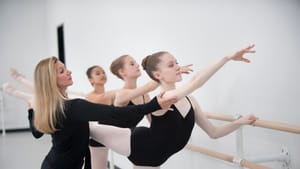Stay in the Loop
BSR publishes on a weekly schedule, with an email newsletter every Wednesday and Thursday morning. There’s no paywall, and subscribing is always free.
Setting the stage for the children
Jaime Santoro and the magical children of Philadelphia Ballet’s The Nutcracker

The first time she saw the Philadelphia Ballet’s Nutcracker, Jaime Santoro knew that’s what she wanted to do. She entered the company’s school in 1983 and while there, she danced almost all of the children’s roles in the ballet, including Marie. As a faculty member and children’s ballet stager for the company, she brings not just her expertise, but her memories to a role she cherishes.
Growing into new roles
The Nutcracker is a massive undertaking, with 115 students aged seven through 18 from the Philadelphia Ballet School and the Metropolitan Ballet Academy participating in two casts—three for some roles—not counting the two children’s choirs. According to Santoro, students audition and “are cast according to their age and on their ability. The angels and soldiers are usually the littlest students.”
Height matters as well. “If they get too tall, that’s hard. They just don’t fit into the costume.” Still, Santoro said that most will return the next year, moving from role to role as they grow in experience as well as height. “If they start out as a little grandchild, they’ve grown enough now to be a party girl or a party boy.”
Santoro loves the complicated process, and she shares that love with the children: “I sit them down at the beginning, and I talk about how important it is to be there, how magical it becomes.” For the smallest students, Santoro begins by teaching them the music. “Sometimes I will have them clap the beat, count with me.” The battle scene seems to be the trickiest for the younger ones, so she stands in the wings and gives the counts to steady the little dancers during performances.
To teach the dances, Santoro said, they work on each section over and over until it becomes muscle memory. When they get into the studio with the company, the children begin to hone their performances. “There’s actually a Drosselmeier there,” she said, “The nutcracker is there to hold. You can see Fritz become, ‘Oh, wait, I am bad there. I get to be bad.’ And then they start to add their own little personalities to it, and each one is different, and that’s what makes it great.”
Marie’s dream journey
The Nutcracker is Marie’s dream and the performance has to build over the first act. Santoro said that she takes one rehearsal with her Maries to run through the part. “I try to physically show them what they need to do, but then it has to be theirs too.” She talks to them about portraying “this little girl that’s coming down the steps looking for her nutcracker in this dark house. And you fall asleep on the couch. But then you see Drosselmeier and he’s your uncle, but now he’s a little scary.” And she shares her own experiences with them: “One time I fell onstage—I literally fell backward, rolled over and jumped up. And I always tell the Maries that story.”
The process continues in the theater, where chaperones bring the children down for their parts and return them to the upstairs dressing rooms for pickup, as choreographed as the dances onstage, all to bring the magical story to life. For Santoro, the magic is in the kids. They are amazing, she told me. “I get goosebumps, watching it all come together, and how much they grow as artists. And also technically, how much their dancing improves. I love that I build a bond with them. They become like my children at the ballet.” Santoro had to step back a bit at the end of this year, as she added a new baby to her troupe of sons back home, but she is looking forward to next year when the process starts anew.
What, When, Where
The Nutcracker. Choreography by George Balanchine. Presented by the Philadelphia Ballet. $25-$287. Through December 28, 2022, at the Academy of Music, 240 S. Broad Street, Philadelphia. (215) 893-1999 or philadelphiaballet.org.
Accessibility
The Academy of Music is wheelchair accessible from the entrance on Broad Street. An accessible entrance on the south side of the building also allows for direct entry to the main lobby. The Kimmel Cultural Campus is wheelchair accessible from both its east (Broad Street) and north (Spruce Street) entrances. Entrances are at sidewalk level (no steps). Ramps and/or level floors enter every level of Verizon Hall and Perelman Theater.
Wheelchair-accessible elevators serve all levels of Verizon Hall and Perelman Theater and are located on all lobby levels of the Kimmel. Wheelchair-accessible elevators access all levels of the Academy of Music.
ADA-compliant restrooms are available on all levels of the Kimmel, accessible to patrons of both Verizon Hall and Perelman Theater, as well as all ancillary spaces. ADA-compliant restrooms are available on the Canteen level of the Academy of Music.
Sign up for our newsletter
All of the week's new articles, all in one place. Sign up for the free weekly BSR newsletters, and don't miss a conversation.

 Camille Bacon-Smith
Camille Bacon-Smith